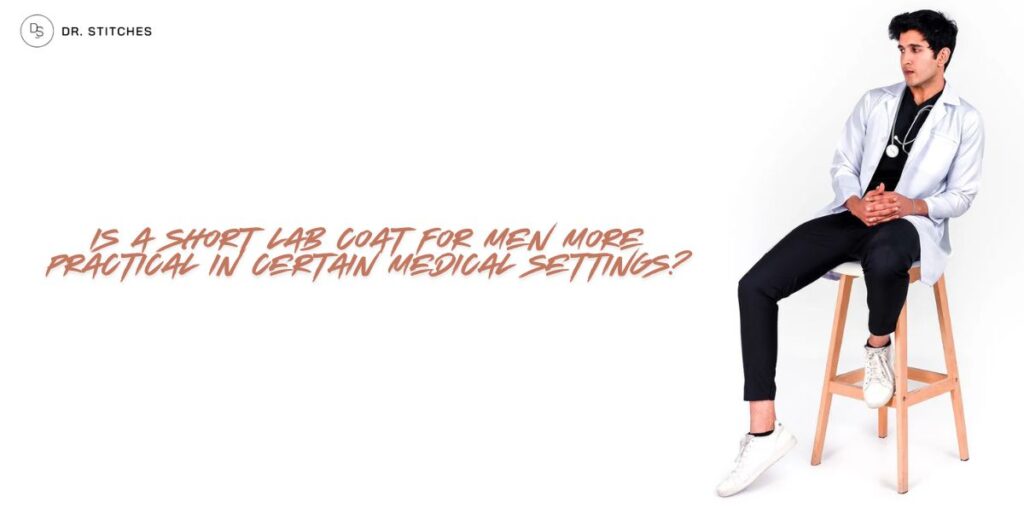The lab coat has long been a symbol of medical authority and professionalism. It signifies not only cleanliness and status but also practicality in demanding environments. Among the different styles available, a short lab coat stands out for its unique blend of utility, style, and flexibility. This raises the question: Is a short lab coat for men more practical in certain medical settings? The answer lies in understanding the dynamic nature of the healthcare environment and the evolving roles of professionals within it.
The Evolving Role of the Lab Coat
Traditionally, lab coats were designed to protect the wearer from spills, contamination, and bodily fluids. The classic full-length coat became the standard among physicians and senior staff. However, as medical practices evolved and healthcare professionals diversified, so did their wardrobe needs. A lab coat men once wore exclusively in longer styles is now offered in shorter, more versatile versions that suit a wider range of duties.
Short lab coats, typically falling just above or below the hip, offer a streamlined option for professionals who require less coverage and more mobility. In fast-paced or hands-on environments, a shorter coat can provide substantial benefits that go beyond aesthetics.
Enhanced Mobility and Ease of Movement
One of the biggest advantages of a short lab coat for men is its ability to promote movement. Whether it’s bending, stretching, or navigating tight spaces, a shorter coat won’t restrict leg movement or get caught on chairs, drawers, or equipment. For professionals who are on the move—like medical residents, physical therapists, nurses, or technicians—freedom of movement can significantly impact their performance and comfort.
Imagine a medical intern rushing between patient rooms or a lab technician navigating a crowded lab station. In such scenarios, a short lab coat makes every step easier, avoiding the entanglement or overheating that can come with longer garments.
Ideal for Teaching Hospitals and Medical Students
Short lab coats have become particularly common in teaching hospitals and among medical students. Many institutions even use coat length to signify rank or experience. Students often wear shorter coats, distinguishing them from fully licensed physicians. In this context, the short coat is not only practical but also symbolic.
From a functional perspective, students benefit from the shorter style because it’s easier to manage while carrying backpacks, clipboards, or other educational tools. It’s also less intimidating to patients and encourages approachability, which is important for budding professionals still learning how to interact with diverse patient populations.
Practicality in Emergency and Outpatient Settings
Emergency rooms (ERs) and outpatient clinics are high-pressure environments where time, speed, and mobility are critical. In these areas, shorter coats offer a clear advantage. They allow healthcare workers to move rapidly, respond quickly, and interact with equipment without being burdened by excess fabric.
In outpatient settings, where patient interactions are brief and focused more on diagnosis and follow-up care than invasive procedures, the full-body protection of a long coat is often unnecessary. A short lab coat men can wear in such settings provides a polished look while supporting the more casual, accessible tone of outpatient care.
Comfort in Warm or Crowded Environments
Hospitals and clinics can sometimes feel crowded and warm, especially in high-traffic departments. Longer coats made of heavy material can trap heat and cause discomfort during long shifts. A short lab coat offers improved airflow and helps professionals stay cool and comfortable throughout their workday.
This added comfort is essential in helping healthcare workers maintain their focus, avoid fatigue, and interact positively with colleagues and patients. The psychological benefit of wearing something that feels light and breathable shouldn’t be underestimated in a high-stress profession like medicine.
Better for Non-Clinical and Administrative Roles
Not everyone in a healthcare setting works directly with patients or in sterile environments. Medical administrators, hospital supervisors, clinical researchers, and pharmaceutical reps often wear lab coats for identification or branding purposes. For these roles, a short lab coat for men is more practical because it offers a clean, professional look without the burden of unnecessary length or weight.
It also aligns better with modern business-casual expectations in healthcare-adjacent roles. Professionals in these positions benefit from a lab coat that looks sharp during meetings but doesn’t interfere with desk work or office movement.
Aesthetics and Modern Styling
Let’s not overlook style. Today’s lab coats come in fitted designs that enhance a professional’s appearance. A short lab coat men choose often features tailored lines, slim fits, and minimalistic touches that match modern styling preferences. Younger doctors and medical professionals tend to prefer these updated cuts, which offer a cleaner silhouette without sacrificing professionalism.
Short coats also pair well with scrubs and are easier to match with different uniforms or personal branding elements, such as embroidered names or logos. When you look good, you feel good—and in medicine, that confidence can carry over into better patient interactions.
When a Long Coat Might Still Be Necessary
While short lab coats offer many advantages, there are still settings where a longer lab coat is more appropriate. In surgical, sterile, or high-risk environments, full-length coverage may be essential for protection. Long coats are better suited to senior physicians, pathologists, and lab researchers dealing with chemicals, blood, or biohazards.
Understanding your work environment is key. In some cases, healthcare professionals even keep both long and short coats on hand to suit different shifts or responsibilities.
Conclusion
So, is a short lab coat for men more practical in certain medical settings? Absolutely. From enhancing mobility and comfort to offering a sharp, modern look, short lab coats serve many professionals well, especially in high-movement or low-risk environments. Whether you’re a student, resident, nurse, or administrator, the right lab coat can support your daily routine while maintaining the polished, competent image that patients and colleagues expect.
The modern healthcare environment demands efficiency, flexibility, and adaptability—qualities that a short lab coat for men delivers in spades.




